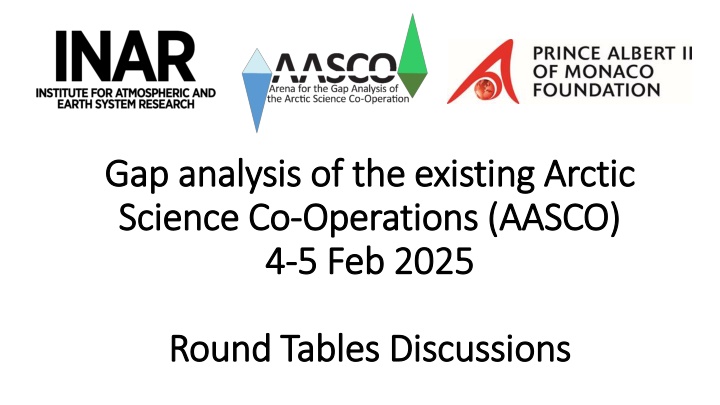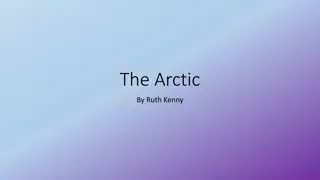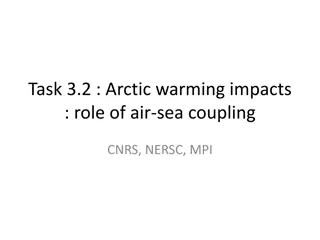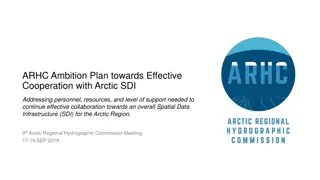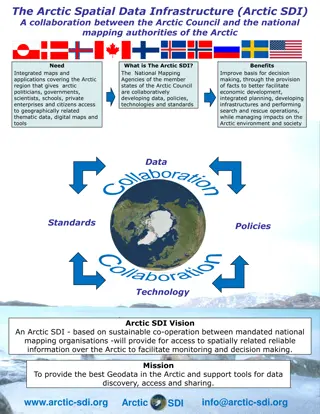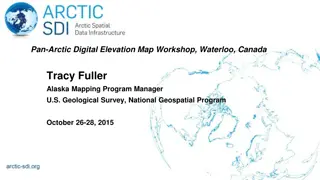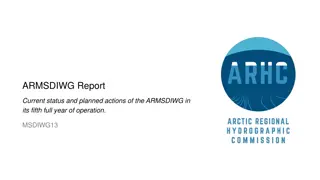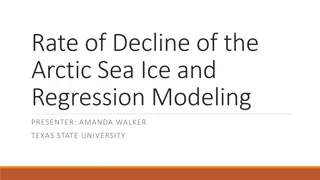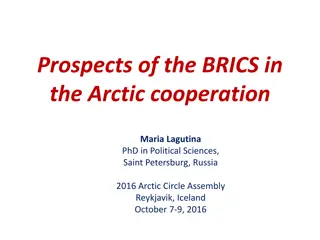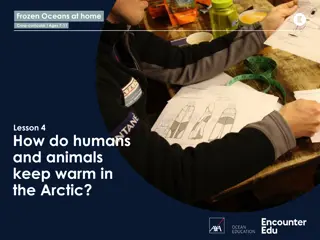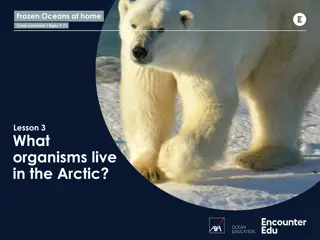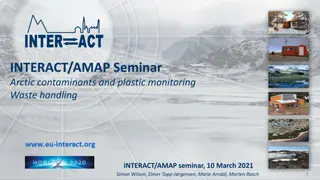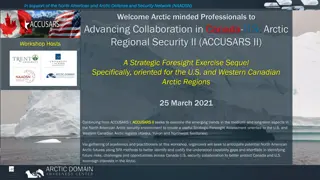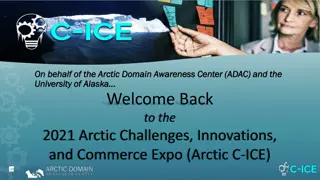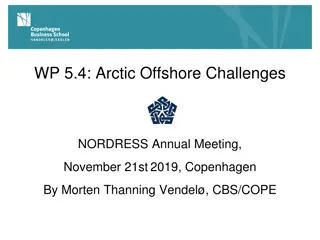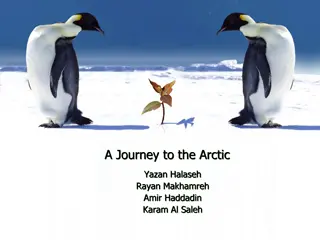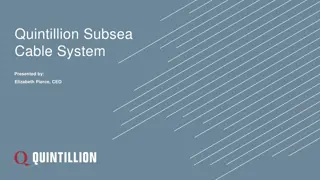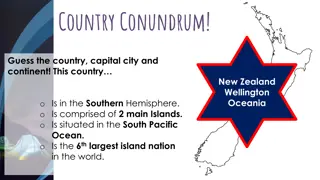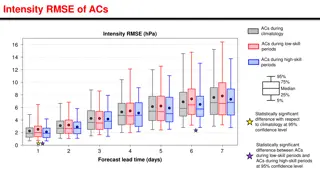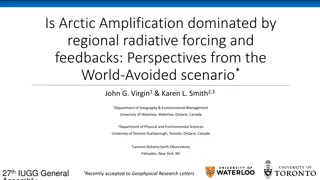Arctic Science Co-Operations Round Table Discussions Feb 2025
"Explore research priorities in Arctic science, focusing on sea ice, Greenland Ice Sheet, short-lived climate forcers, and local Arctic processes. Address knowledge gaps, monitoring strategies, and climate projections amidst challenges of inaccessibility. Engage experts in guiding discussions on innovative research goals for the International Polar Year 2032/33 and beyond."
Download Presentation

Please find below an Image/Link to download the presentation.
The content on the website is provided AS IS for your information and personal use only. It may not be sold, licensed, or shared on other websites without obtaining consent from the author.If you encounter any issues during the download, it is possible that the publisher has removed the file from their server.
You are allowed to download the files provided on this website for personal or commercial use, subject to the condition that they are used lawfully. All files are the property of their respective owners.
The content on the website is provided AS IS for your information and personal use only. It may not be sold, licensed, or shared on other websites without obtaining consent from the author.
E N D
Presentation Transcript
Gap analysis of the existing Arctic Gap analysis of the existing Arctic Science Co Science Co- -Operations (AASCO) Operations (AASCO) 4 4- -5 Feb 2025 5 Feb 2025 Round Tables Discussions Round Tables Discussions
Table Table- -1 1 Petteri Uotila, University of Helsinki Co- -chair chair Angelika Humbert, The Alfred Wegener Institute Arctic Sea ice and Arctic Sea ice and Greenland Ice Sheet Greenland Ice Sheet (ICARP RPT 1) (ICARP RPT 1) Chair Chair Co Guiding Guiding questions questions What are the main research priorities related to Arctic sea ice? How could observations and monitoring support these research priorities? What would be the next steps in implementing supportive actions How to monitor adequately the state of the Greenland Ice Sheet - from surface processes to sea level rise? How to increase knowledge on processes of the ice sheet hydrology? How to do we best foster coordinated monitoring programs of Greenland in the International Polar Year 2032/33?
Table Table- -2 2 Chair Chair Co Co- -chair chair Yubao Qui, Digital Belt and Road Program (DBAR) Short Short- -lived climate forcers (SLCFs) (ICARP RPT 1) lived climate forcers (SLCFs) (ICARP RPT 1) Heikki Lihavainen, SIOS Guiding Guiding questions questions What would be the main research priorities and knowledge gaps in context SLCF and Arctic climate? What observations and where are required to fill the knowledge gaps and improve Arctic climate projections? How to avoid biases caused by SLCF data gaps in understanding SLCF emissions and effects now and in climate projections as half of the Arctic is in many ways inaccessible? What would be ambitious enough goals for 5thIPY in SLFC context?
Table Table- -3 3 Chair Chair Co Co- -chair chair Interplay between Arctic processes and the coupled climate system (ICARP RPT 1) Interplay between Arctic processes and the coupled climate system (ICARP RPT 1) Timo Vihma Finnish Meteorological Institute Dorotea Iovino, Foundation Euro-Mediterranean Centre on Climate Change (CMCC) Guiding Guiding questions questions What are the key knowledge gaps and research priorities regarding local physical processes in the Arctic atmosphere, ocean, and sea ice? How are local processes in the Arctic atmosphere, ocean, and sea ice influenced by heat and moisture transports to the Arctic How are climate feedback effects expected to evolve during this century and beyond? How do changes in the Arctic system impact weather and climate in mid-latitudes?
Table Table- -4 4 Chair Chair Co Co- -chair chair University of Cambridge Climate Climateinterventions interventions( (climateinterventions.org climateinterventions.org, ICARP RPT 7) John Moore, Arctic Centre, University of Lapland Marc Macias-Fauria, Department of Geography & the Scott Polar Research Institute , ICARP RPT 7) Guiding Guiding questions questions What systems in the Arctic are most at risk of collapse, and what, if anything, might delay or avert them? What systems might be helped with only local (domestic law) interventions? What field tests in the Arctic might be feasible - socially, legally and technically? How might preserving the Arctic cryosphere be paid for?
Table Table- -5 5 Steve Arnold, University of Leeds Kathy Law, LATMOS CNRS, Paris / Alexander Baklanov University of Copenhagen Research priorities around Arctic air pollution Research priorities around Arctic air pollution(PACES) (PACES) Chair Chair Co Co- -chair chair Guiding Guiding questions questions 1. What are key remaining knowledge gaps in understanding sources and processing of local emitted air pollutants in the Arctic? 2. What are the research priorities in better understanding impacts of local Arctic air pollution on health, ecosystems, climate? 3. Which science questions could be better addressed by improving frequency and coverage of regular vertical profile sampling of air pollution in the Arctic? Additional questions; How to improve regular vertical sampling in the Arctic (PACES) 1. Which science questions could be better addressed by improving frequency and coverage of regular vertical profile sampling (aerosol, trace gas, temperature, humidity) in the Arctic? 2. What are the potential platforms available to undertake routine vertical profile sampling? 3. Which technological / instrumentation developments can we expect in advance of IPY (2032-33) to help enable routine vertical sampling?
Table Table- -6 6 Chair Chair Co Co- -chair chair The role of Co The role of Co- -Production and local communities (ICARP RPT 3, 5) Production and local communities (ICARP RPT 3, 5) Cana Itchuaqiyaq, Center for Sustainable Engagement in the Arctic Hanna Snellman, Univeristy of Helsinki Guiding Guiding questions questions How do you ensure that the principle of nothing about us without us guides your research, particularly when working with Arctic Indigenous communities? Beyond this principle, what other ethical guidelines do you prioritize to ensure your research aligns with the values and self-determination of Indigenous peoples? What is your process to actively involve local communities as co-creators in shaping, conducting, and disseminating your research to make it meaningful and beneficial to them? How do you approach language justice and meaningful access in your work, such as sharing research findings in Indigenous languages or through culturally appropriate and accessible mediums?
Table Table- -7 7 Chair Chair Co Co- -chair chair University Pan Pan- -Arctic Science Research Collaboration (ICARP RPT 4) Arctic Science Research Collaboration (ICARP RPT 4) Jennifer Spence, Harvard Kennedy School Kamrul Hossain, Northern Institute for Environmental and Minority Law, Arctic Centre, Guiding Guiding questions questions To what extent is Pan-Arctic research collaboration important? What is your vision for Pan-Arctic research collaboration in 2035? What are the challenges for Pan-Arctic research collaboration? What are the tools available and/or do we need to advance Pan-Arctic research collaboration?
Table Table- -8 8 Chair Chair Co Co- -chair chair Data Data- -sharing, AI (e.g. ICARP RPT 2, 5) sharing, AI (e.g. ICARP RPT 2, 5) Pier Luigi Buttigieg, the Alfred Wegener Institute, Helmholtz Centre for Polar and Marine Research J rn Kristiansen, The Norwegian Meteorological Institute Guiding Guiding questions questions How can data platforms incorporate Indigenous and local knowledge alongside or integrated with scientific data? What are the most critical unmet needs of diverse user groups, and how can data-driven services be designed to meet those needs effectively? Can interdisciplinary approaches enhance the availability, quality and usability of environmental data? How do geopolitical challenges and regulatory frameworks impact polar data sharing and service provision, and what actionable recommendations can address these issues? The (artificial) elephant in the room: How do we leverage the AI boom for better data sharing, without it undermining foundational architectures? Why can't I find all Arctic data (or even metadata) from trusted sources across all Arctic platforms? What is working in delivering scientific data to other societal actors in a way they can react to? Why are most scientific data products still underused or invisible? What can we - as an Arctic community - do now to improve the situation?
TABLE : TABLE : name Discussion Discussion points name points TBD TBD
TABLE : TABLE : name Key Message(s) Key Message(s) name
